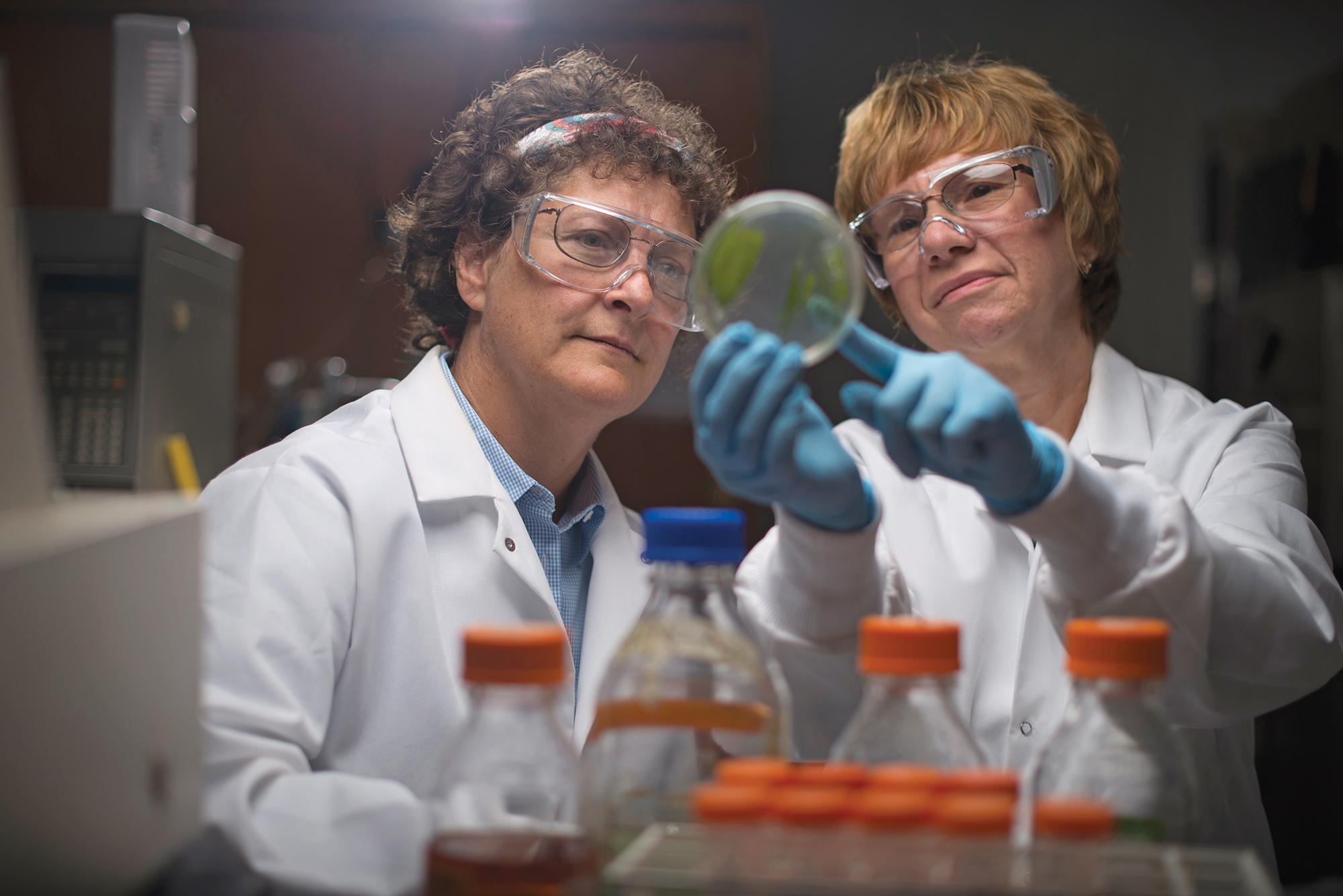Feature Photo: Susan Pfiffner (left) and Tatiana Vishnivetskaya, University of Tennessee, Knoxville researchers dig into potential impact of frozen microorganisms in Siberia
Photo by Adam Brimer
By Nancy Henderson
When many people think of Siberia, they imagine a vast, frozen tundra with few signs of life and miserably frigid temperatures plunging well below zero. They would be right—most of the time. In summer, however, the top layers of ground thaw, leaving deeply buried, permanently frozen soil called permafrost. And permafrost, according to UT Knoxville microbiologist Tatiana Vishnivetskaya, who explored the sparsely populated region in August 2015, could lead to important insights about climate control and the ability of some “living fossils” to survive in extreme environments.
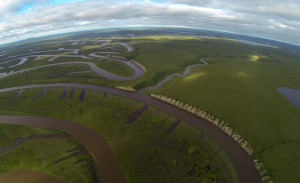
“In the tundra, summer is very short. In the beginning of June, there is sometimes still snow on the ground, and the ground is frozen,” says Vishnivetskaya, the project’s principal investigator and a research associate with the UT Knoxville Center for Environmental Biotechnology (CEB). “By the end of August, there is usually already snow on the ground. So there is only a small window of time for the researchers to be in the field.”
Still, despite daytime temperatures that soared to well above 80 degrees, the researchers endured “the worst weather you can imagine” while collecting soil samples near the Alazeya River. “There were tons of mosquitoes, millions of them,” Vishnivetskaya says, laughing. “We were sweating all the time and covered in mosquito bites.”

Funded by a $1.5 million grant from the National Science Foundation’s Dimensions of Biodiversity program, the five-year Siberian study is designed to unearth the mysteries of permafrost that has never completely thawed since freezing 5,000 to 3 million years ago, potentially housing trapped, dormant microorganisms that could be revived and used in various ways.

The collaborative team is comprised of scientists from UT Knoxville, Princeton University and the Laboratory of Soil Cryology, a division of the Institute of Physicochemical and Biological Problems in Soil Science of the Russian Academy of Science in Puschchino, about 60 miles south of Moscow. Vishnivetskaya, who hails from Ukraine and earned her early degrees at Moscow State University, used her strong Russian connections to help pave the way for last year’s field study near the East Siberian Sea, home to the oldest known sediments in the Northern Hemisphere.
Susan Pfiffner, a UT Knoxville research associate professor of microbiology who has studied life in South African gold mines and other extreme environments, is co-principal investigator. (She and Vishnivetskaya previously worked together on a permafrost study in the Canadian Arctic.) “Part of the study is to look at evolution,” Pfiffner says. “What organisms are there? Are they the same in different formations from different geological times? Are they alive?
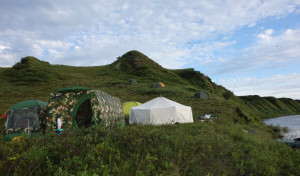
“If you look at samples from Antarctica and other places, it’s obvious there are organisms that survive in very cold environments,” she adds, referring to past research that identified enzymes now standard in cold-water laundry detergent, others that give denim a stonewashed look, and plants previously believed extinct that sprouted from frozen seeds. “So we’re hoping to find that here.”
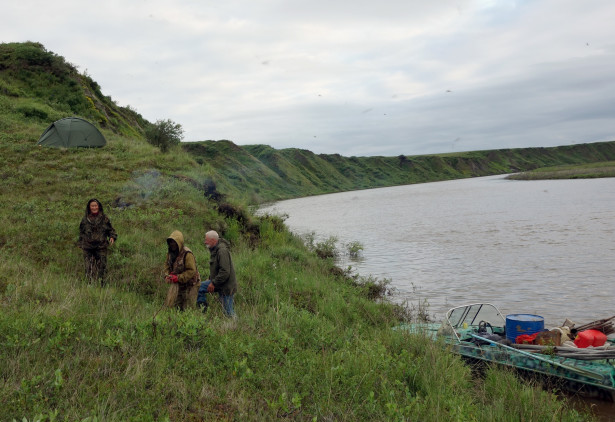
Reachable only by helicopter, the virtually unexplored site in the northeast corner of Russia was chosen for its rich layers of ancient sediment, which could be accessed with minimal drilling. Once there, Vishnivetskaya and her hands-on team of four drillers from the Puschchino lab and three local residents set up camp in a lush, grassy field overlooking the winding, ribbon-like river. Sloshing through terrain saturated with melted snow, they bored into the stratified cliffs, collecting core samples from different depths. Then, using sterilized scalpels and knives, Vishnivetskaya pared away the melted layers to get to each “high-quality nugget” inside. Every other day, the samples were transferred to an ice-covered “natural freezer”—a sort of root cellar storage area—two hours away.
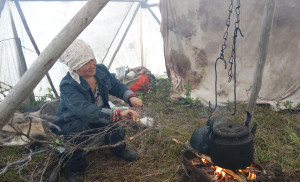
With no towns nearby, each day the researchers boiled water in cast-iron kettles hung over an open fire and ate fish caught from the river. Their 16-day excavation experience happened to coincide with the annual “polar days,” 24-hour periods of daylight when the sky never grows dark.
Permafrost studies like those conducted in Siberia could impact human life in multiple ways, the researchers say. Newly discovered enzymes could be used to remediate contaminated soil. Some might scrub methane from the environment or diffuse black carbon, a byproduct of coal-burning and other industry exhaust.
“This is enormously important in terms of how microorganisms might influence the geochemical environment in response to climate-change effects,” says CEB director Dr. Gary Sayler “In addition to that, there’s just fundamental knowledge to be gained about what kind of microbes are in these aging sediments. They might even relate to these recent findings on Mars, where they now have evidence of frozen and liquid water. The analogy there to extraterrestrial life is really quite relevant.”
The Siberian study also illustrates the important role of the CEB, Sayler notes. “This is a real nice example of how interdisciplinary research faculty come together within this center concept to promote really high-level, world-respected science here at UTK.”
Moving forward, the project will train young scientists at the undergraduate, graduate and post-doctoral levels. Later this year, Vishnivetskaya will return to Siberia with a small group of UT Knoxville students who will collect permafrost samples from marine soil and work in the Russian lab, where they will learn how to conduct research with colleagues from other cultures.
“These are wonderful opportunities to stimulate student creativity and imagination,” says Sayler. “It also works really well to help globalize the students.”
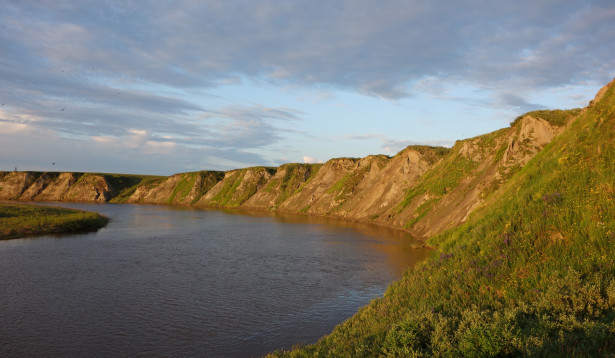
In addition, UT Knoxville researchers plan to host a weeklong molecular biology training workshop for high school biology teachers across the state. The teachers will receive training in how to use archived permafrost microorganisms in the classroom to help students understand extreme conditions around the world, as well as the probability of finding new species and enzymes that might benefit humans and help protect the planet, including the mysterious land of extremes in the country where Vishnivetskaya grew up.
“It is beautiful, and if climate change or something else happens, we will lose a biosystem in the tundra,” she says. “A lot of animals and people who live there depend on the conditions there. This is a very difficult life, but the people are used to it. Here, we’re always in a hurry and have a lot of stress. When you arrive in that remote area, you understand that nobody hurries because they have plenty of time and they can do that tomorrow.”
